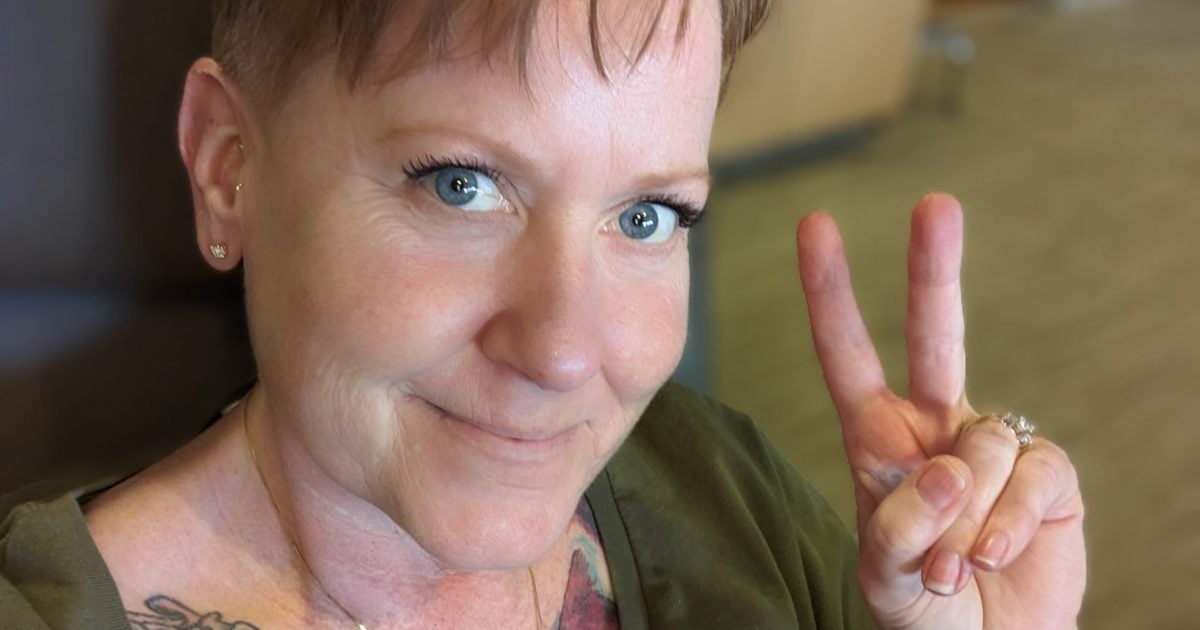Know Your Family Health History: It Matters
- Tami Winther, a 52-year-old breast and ovarian cancer survivor, didn’t know she carried the BRCA1 mutation until after she was diagnosed with breast cancer.
- A BRCA1 or BRCA2 mutation can increase a woman’s risk of developing both breast and ovarian cancer and these genes can be passed down through families.
- After undergoing a double mastectomy to treat her breast cancer, Tami also had a hysterectomy to reduce her chances of developing ovarian cancer down the line. She didn’t know that even with the preventative surgery, she still could and ultimately did develop ovarian cancer.
- “I think what I’d really want anybody to take away from all of this is that you have to get educated. Don’t be afraid to do your research … you need to be able to speak to your doctors on an intelligent level about what’s going on in your body. You have to be engaged,” Tami tells SurvivorNet.
Tami is both a breast cancer and ovarian cancer survivor — and she didn’t find out she carried a BRCA1 mutation, which makes a person significantly more likely to develop both breast and ovarian cancer, until after her first diagnosis.
Read More
BRCA Mutations & Cancer Risk
Her first cancer diagnosis came in her early 40s. She was living well and feeling healthy, had lost 70 pounds, had a great job, and was in a new relationship.
“I will never forget the day I was in the shower and I found the lump myself. I sincerely thought because I had lost the amount of weight that I had that really helped me in order to locate the lump. I knew what it was. I cried in the shower, I got out, I called my boyfriend, I told him he was fired because he should have found it instead of me,” Tami says.
Genetic Testing for Breast Cancer Risk
After a biopsy, Tami began discussing family history with her oncologist. “At 43, I really hadn’t realized how many of my family members had been affected by cancer and I had no idea how much it would impact my health. So in those discussions early on, BRCA testing came up and it was absolutely something I felt was totally necessary for me to do given the family history.”
A mutation in the BRCA1 or BRCA2 gene can increase a woman’s risk of developing both breast and ovarian cancer. These genes can be passed down through families. If you find out you do have a mutation, it’s important to speak to your doctor about options.
“Women who are found to test positive for a genetic mutation really have two options,” Dr. Elisa Port, Chief of Breast Surgery at Mount Sinai Health System, told SurvivorNet in a previous conversation. “One is what’s called high-risk surveillance, which means we check them every six months or so mammograms, MRIs with the hope that if, God forbid, they develop breast cancer, we pick it up early
“… For the woman who wants to be more proactive about actually preventing breast cancer, or as we say reducing her risk, unfortunately, the only way to do that is to remove the actual tissue at risk and that is the breast tissue.”
Dr. Elisa Port explains the options for women with high breast cancer risk.
Unfortunately, Tami’s BRCA mutation was not detected until she was already diagnosed with breast cancer. In fact, she got her BRCA results right before she was scheduled to undergo a single mastectomy, or a surgery to remove one breast.
“We received my BRCA results, which were BRCA1 positive, about 48 hours before that surgery was scheduled. So that quickly changed my mind as far as what I needed to do. I knew instantly that it needed to be a double mastectomy,” Tami explains.
After surgery, Tami underwent chemotherapy and eventually a hysterectomy to reduce the risk that she would also develop ovarian cancer down the line.
A Second Diagnosis
“One of my last treatments for breast cancer was a full hysterectomy, including cervix, and I thought that that was one of my last steps on that road, that a prophylactic [preventative] surgery to help eliminate some chances was what I needed to do and what I felt was important and to protect myself,” Tami explains.
She lived cancer-free for more than five years and got involved with advocacy and raising awareness about inherited cancer risk.
However, even with the hysterectomy, which removes the uterus and cervix, Tami was diagnosed a second time — this time, with a form of ovarian cancer known as peritoneal cancer.
“Being diagnosed with peritoneal cancer, a form of ovarian cancer, when I knew that I hadn’t had ovaries for five and a half, six years, was absolutely a gut punch that I never expected. I never had anybody in my medical circle tell me that that kind of cancer was still possible after hysterectomy. I felt really cheated and angry about that,” she explains.
Looking back, Tami says she did feel some symptoms of ovarian cancer — like feeling full quickly or being bloated — but they were non-specific and she wrote them off, as many women do.
Dr. Beth Karlan explains that ovarian cancer symptoms are often vague.
The diagnosis, especially after the preventative measures she had taken, was naturally devastating to Tami.
“I thought that I had done everything that I was supposed to do, that I had eliminated the chances,” she says. “It was explained to me that there are still ovarian like cells within your abdomen even post hysterectomy and due to my BRCA1 status that lit things up, that got things going.”
After the ovarian cancer diagnosis in 2021, Tami completed her chemotherapy regiment in January of 2022 and then began maintenance therapy with a PARP inhibitor, Lynparza (olaparib), which is used for people with BRCA-mutated ovarian cancer.
“I started Lynparza is February of ’22 and have taken it for two and a half years,” Tami explains. She did note she’s had some side effects, like fatigue, a bit of nausea, and joint pain, but overall, taking the PARP inhibitor has just become a normal part of her life.
“…They don’t interrupt my daily schedule. For me, it’s like taking a couple aspirin and it’s given me an opportunity to lead as normal a life [as possible] without having to stop and go to the hospital and have some kind of formal treatment every day.”
Living & Thriving With Cancer
While she’s currently dealing with her first recurrence, Tami says that this time, she’s more prepared to take on treatment and cope with the side effects that it may bring.
She’s also using her experience to educate and inspire others.
“I think what I’d really want anybody to take away from all of this is that you have to get educated. Don’t be afraid to do your research. Stick with reputable sources and remember that not everything applies to you. I’m not a statistic, you are not a statistic, but you need to be able to speak to your doctors on an intelligent level about what’s going on in your body. You have to be engaged,” she says.
“I always say to ask questions, demand answers, be involved in your own care. You are your one and only best advocate. No one else will be your best advocate.
And finally, perhaps most importantly: “if there’s any cancer history in your family, then you must be genetically tested.”
Learn more about SurvivorNet's rigorous medical review process.


